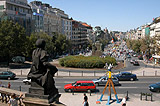Wenceslas Square - the place that never sleeps
What’s so special about it?
 Well, on the first place it’s a perfect place for going shopping, meeting friends or just hanging out. It is in fact one of Praguers’ favorite meeting places (“at the Horse’s tail”) and a great spot to start your itinerary around the city.
Well, on the first place it’s a perfect place for going shopping, meeting friends or just hanging out. It is in fact one of Praguers’ favorite meeting places (“at the Horse’s tail”) and a great spot to start your itinerary around the city.
Firms’ administrative offices, luxurious shops, hotels, casinos, fancy restaurants and discotheques, exchange offices, food stands and hundreds and hundreds of tourists and locals passing by every minute make it one of the most crowded places in Prague. It seems to be the place where nobody ever sleeps:-)
Except from that, one could take it for a normal, regulary square just like so many others on the palnet. But even so, it is already worthwhile seeing. Outdoor exhibitions, the tram café, the bronze equestrian statue of St. Wenceslas and the golden cupola of the National Museum dominating the horizon make the square even more interesting.
Square or boulevard?
....maybe something in between: The area takes up 45000 square meters and the rectangular square is 750 meters (820 yards) long and 60 meters (65 yards) wide. Cars can go on both ways and trams intersect it at the middle.
The history of the square goes back to 1348, when Charles IV (Czech king and Holy Roman Emperor) designed it as a horse market. After 600 years it is now a national symbol and the place where most demonstrations take place.
Who was St. Wenceslas (Sv. Vaclav)?
 St. Wenceslas was actually a loved Czech King propagating Christianity. He ruled over Prague in the 10th century. Legend says that he was murdered when he was going to the morning religious service, by the mercenaries sent by his brother Boleslav. He represents national Czech continuity and nationhood and he is celebrated every year on the 27th September. The legendary royal brothers Wnceslas (Václav) and Boleslav are the Czech correspondents of Cain and Abel from the Holy Bible or, in other words, of Good and Evil.
St. Wenceslas was actually a loved Czech King propagating Christianity. He ruled over Prague in the 10th century. Legend says that he was murdered when he was going to the morning religious service, by the mercenaries sent by his brother Boleslav. He represents national Czech continuity and nationhood and he is celebrated every year on the 27th September. The legendary royal brothers Wnceslas (Václav) and Boleslav are the Czech correspondents of Cain and Abel from the Holy Bible or, in other words, of Good and Evil.
The homage to Jan Palach.
The 20-year old philosophy student, Jan Palach set fire to himself on 16th January 1969, protesting against the Soviet invasion in Prague. His funeral ceremony was followed by three quarters of a million people and turned into a major protest against the occupation. After the end of the Communist Era in 1989, a bronze cross was embedded at the place where he fell, close to the statue of St. Wenceslas.
A few meters below the big horse is also a small round flowerbed with a low-key memorial “to the victims of Communism.”
For more pictures see Wenceslas Square photo gallery
